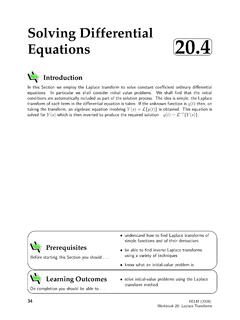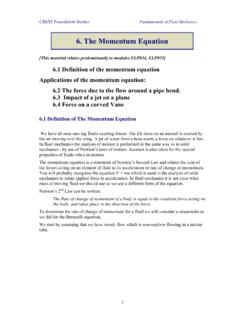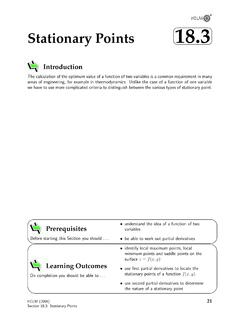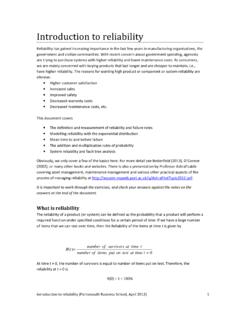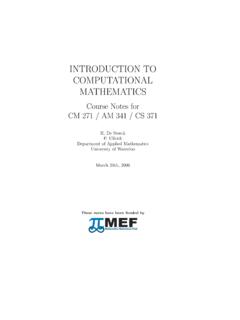Transcription of The Exponential Form of a Complex Number 10
1 The Exponential Formof a Complex Number this Section we introduce a third way of expressing a Complex Number : the Exponential form . Weshall discover, through the use of the Complex Number notation, the intimate connection betweenthe Exponential function and the trigonometric functions. We shall also see, using the exponentialform, that certain calculations, particularly multiplication and division of Complex numbers, are eveneasier than when expressed in polar Exponential form of a Complex Number is in widespread use in engineering and science.'&$%PrerequisitesBefore starting this Section you should.. be able to convert from degrees to radians understand how to use the Cartesian andpolar forms of a Complex Number be familiar with the hyperbolic functionscoshxandsinhx'&$%Learning OutcomesOn completion you should be able to.
2 Explain the relations between theexponential function exand thetrigonometric functionscosx,sinx interchange between Cartesian, polar andexponential forms of a Complex Number explain the relation between hyperbolic andtrigonometric functions20 HELM (2008):Workbook 10: Complex Numbers 1. Series expansions for Exponential and trigonometricfunctionsWe have, so far, considered two ways of representing a Complex Number :z=a+ibCartesian formorz=r(cos +isin )polar formIn this Section we introduce a third way of denoting a Complex Number : theexponential a real Number then, as we shall verify in16, the Exponential Number e raised to thepowerxcan be written as a series of powers ofx:ex= 1 +x+x22!+x33!+x44!+ in whichn! =n(n 1)(n 2)..(3)(2)(1)is the factorial of the integern. Although there arean infinite Number of terms on the right-hand side, in any practical calculation we could only use afinite Number .
3 For example if we choosex= 1(and taking only six terms) thene1 1 + 1 +12!+13!+14!+15!= 2 + + + + is fairly close to the accurate value of e= (to 5 )We ask you to accept that ex, for any real value ofx, is thesame as1 +x+x22!+x33!+ andthat if we wish to calculate exfor aparticular valueofxwe will only take a finite Number of termsin the series. Obviously the more terms we take in any particular calculation the more accurate willbe our we shall also see in16, similar series expansions exist for the trigonometric functionssinxandcosx:sinx=x x33!+x55! x77!+ cosx= 1 x22!+x44! x66!+ in whichxis measured in observant reader will see that these two series forsinxandcosxare similar to the series for the use of the symbol i (where i2= 1)we will examine this close the series for exreplacexon both left-hand and right-hand sides by i to give:ei = 1 + (i ) +(i )22!
4 +(i )33!+(i )44!+(i )55!+ Then, as usual, replace every occurrence of i2by 1to giveei = 1 +i 22! i 33!+ 44!+i 55!+ HELM (2008):Section : The Exponential form of a Complex Number21which, when re-organised into real and imaginary terms gives, finally:ei =[1 22!+ 44! ]+i[ 33!+ 55! ]= cos +isin Key Point 8ei cos +isin Example 5 Find Complex Number expressions, in Cartesian form , for(a) ei /4(b) e i(c) ei We use Key Point 8:Solution(a) ei /4= cos 4+isin 4=1 2+i1 2(b) e i= cos( 1) +isin( 1) = i( )don t forget: useradians(c) ei = cos +isin = 1 +i(0) = 12. The Exponential formSincez=r(cos +isin )and since ei = cos +isin we therefore obtain another way in whichto denote a Complex Number :z=rei , called theexponential Point 9 The Exponential form of a Complex Number isz=rei in whichr=|z|and =arg(z)soz=rei =r(cos +isin )22 HELM (2008):Workbook 10: Complex Numbers TaskExpressz= 3ei /6in Cartesian form , correct to 2 Key Point 9:Your solutionAnswerz= 3ei /6= 3(cos 6+isin 6)= 3( + )= + 6 Ifz=rei andw=tei then find expressions for (a)z 1(b)z (c)zwSolution(a) Ifz=rei thenz 1=1rei =1re i using the normal rules for indices.
5 (b) Working in polar form : ifz=rei =r(cos +isin )thenz =r(cos isin ) =r(cos( ) +isin( )) =re i sincecos( ) = cos andsin( ) = sin . In fact this reflects the general rule: to find thecomplex conjugate of any expression simply replace i by i wherever it occurs in the expression.(c)zw= (rei )(tei ) =rtei ei =rtei +i =rtei( + )which is again the result we are familiar with:when Complex numbers are multiplied their moduli multiply and their arguments see that in some circumstances the Exponential form is even more convenient than the polar formsince we need not worry about cumbersome trigonometric (2008):Section : The Exponential form of a Complex Number23 TaskExpress the following Complex numbers in Exponential form :(a)z= 1 i (b)z= 2 + 3i (c)z= solution(a)Answerz= 2ei7 /4(or, equivalently, 2e i /4)Your solution(b)Answerz= 13ei( )Your solution(c)Answerz= 6ei 3.
6 Hyperbolic and trigonometric functionsWe have seen in subsection 1 (Key Point 8) thatei = cos +isin It follows from this thate i = cos( ) +isin( ) = cos isin Now if we add these two relations together we obtaincos =ei +e i 2whereas if we subtract the second from the first we havesin =ei e i 2iThese new relations are reminiscent of the hyperbolic functions introduced in6. There wedefinedcoshxandsinhxin terms of the Exponential function:coshx=ex+e x2sinhx=ex e x2In fact, if we replacexby i in these last two equations we obtain24 HELM (2008):Workbook 10: Complex Numbers cosh(i ) =ei +e i 2 cos andsinh(i ) =ei e i 2 isin Although, by our notation, we have implied that bothxand are real quantities in fact theseexpressions forcoshandsinhin terms ofcosandsinare quite Point 10 Ifzisanycomplex Number thencosh(iz) coszandsinh(iz) isinzEquivalently, replacingzby iz:coshz cos(iz)and isinhz sin(iz)TaskGiven thatcos2z+ sin2z 1for allzthen, utilising Complex numbers, obtainthe equivalent identity for hyperbolic solutionAnswerYou should obtaincosh2z sinh2z 1since, if we replacezbyizin the given identity thencos2(iz) + sin2(iz) 1.
7 But as noted abovecos(iz) coshzandsin(iz) isinhzso the analysis similar to that in the above task leads toOsborne s rule:Key Point 11 Osborne s RuleHyperbolic function identities are obtained from trigonometric functionidentities by replacingsin bysinh andcos bycosh except thatevery occurrence ofsin2 is replaced by sinh2 .HELM (2008):Section : The Exponential form of a Complex Number25 Example 7 Use Osborne s rule to obtain the hyperbolic identity equivalent to1 + tan2 sec2 .SolutionHere1 + tan2 sec2 is equivalent to1 +sin2 cos2 1cos2 . Hence ifsin2 sinh2 andcos2 cosh2 then we obtain1 sinh2 cosh2 1cosh2 or, equivalently,1 tanh2 sech2 Engineering Example 1 Feedback applied to an amplifierFeedback is applied to an amplifier such thatA =A1 AwhereA , Aand are Complex the amplifier gain,A is the gain with feedback and is the proportion of the output which has been fed AGainFeedback loopFigure 8: An amplifier with feedback(a)If at 30 Hz,A= 500and = i/9, calculateA in Exponential form .
8 (b)At a particular frequency it is desired to haveA = 300e5 i/9where it is known thatA= 400e11 i/18. Find the value of necessary to achieve this gain (2008):Workbook 10: Complex Numbers Mathematical statement of the problemFor (a): substituteA= 500and = i/9intoA =A1 Ain order to findA .For (b): we need to solve for whenA = 300e5 i/9andA= 400e11 analysis(a)A =A1 A= 5001 i/9 ( 500)= 5001 + i/9 Expressing the bottom line of this expression in Cartesian form this becomes:A = 5001 + cos(8 9) + (8 9) 500 + both the top and bottom lines in Exponential form we get:A 500ei (b)A =A1 A A (1 A) =A AA =A A =A AAA =1A 1A So =1A 1A =1400e11 i/18 1300e5 i/9 11 i18 5 i/9 Expressing both Complex numbers in Cartesian form gives = cos( 11 18) + ( 11 18) cos( 5 9) ( 5 9)= 10 4+ 10 4i= 10 to 3 significant figures = 10 (2008):Section.
9 The Exponential form of a Complex standard identities in trigonometry aresin 2z 2 sinzcoszandcos 2z cos2z Osborne s rule to obtain the corresponding identities for hyperbolic (a+ib)in Cartesian the following Complex numbers in Cartesian form (a)3ei /3(b) e 2 i(c) ei /2ei the following Complex numbers in Exponential form (a)z= 2 i (b)z= 4 3i (c)z 1wherez= 2 the real and imaginary parts ofsinh(1 +i 6). 2z 2 sinhzcoshz,cosh 2z cosh2z+ (a+ib) sinhacoshib+ coshasinhib sinhacosb+ cosha(isinb) sinhacosb+icoshasinb3. (a) +i( )(b) 1 (c) +i( )4. (a) 5ei( )(b)5ei( )(c)2 3i= 13ei( )therefore12 3i=1 13e i( ) (1 +i 6) = 32sinh 1 +i2cosh 1 = +i( )28 HELM (2008):Workbook 10: Complex Numbers

